LLM guide
A complete guide to RAG evaluation: metrics, testing and best practices
RAG – short for Retrieval-Augmented Generation – is one of the most popular ways to build useful LLM applications. It lets you bring in external knowledge so your AI assistant or chatbot can work with more than just what the LLM memorized during training.
But adding retrieval functionality makes things more complex.
Suddenly you are not just prompting an LLM – you’re building a pipeline. There is chunking, search, context assembly, and generation. And when something goes wrong, it’s not always clear where the problem is. Did the model hallucinate? Or did it never get the right information to begin with?
That’s where you need evaluations: a way to test how well your RAG system is working – and catch what isn’t, ideally before users do.
In this guide, we’ll break down how to evaluate and test RAG systems, both during development and in production. We’ll cover:
- How to evaluate retrieval and generation separately
- How to use LLMs for evaluation and synthetic data generation
- Tips for building test sets, running experiments, and monitoring in production
We’ll also introduce Evidently – an open-source library and platform that helps you evaluate and monitor RAG systems, with or without code.
TL;DR
- RAG evaluations help assess how well a Retrieval-Augmented Generation system retrieves relevant context and generates grounded, accurate responses.
- RAG consists of two core parts: retrieval (finding useful info) and generation (producing the final answer). These can be evaluated separately.
- Retrieval evaluation includes ranking metrics like recall@k with ground truth, or manual/LLM-judged relevance scoring of retrieved context.
- Reference-based generation evaluation compares outputs to correct answers using LLM judges or semantic similarity.
- Reference-free generation evaluation can check for response faithfulness, completeness, tone or structural qualities.
- Synthetic test data helps bootstrap evaluations by generating realistic question–answer pairs from the knowledge base.
- Stress- and adversarial testing help ensure responses remain safe and aligned even when presented with risky inputs or edge cases.
Test fast, ship faster. Evidently Cloud gives you reliable, repeatable evaluations for complex systems like RAG and agents — so you can iterate quickly and ship with confidence.
What is RAG?
RAG stands for Retrieval-Augmented Generation. It’s a way to build LLM applications that can answer questions using external data – like product docs, support content, or internal knowledge bases – instead of relying only on what the model saw during training.
For example, if you are building a customer support chatbot, you can’t expect the LLM to know your company policies. Instead, you can set up a system that retrieves the relevant document when the user asks a question – and uses it to generate the response.
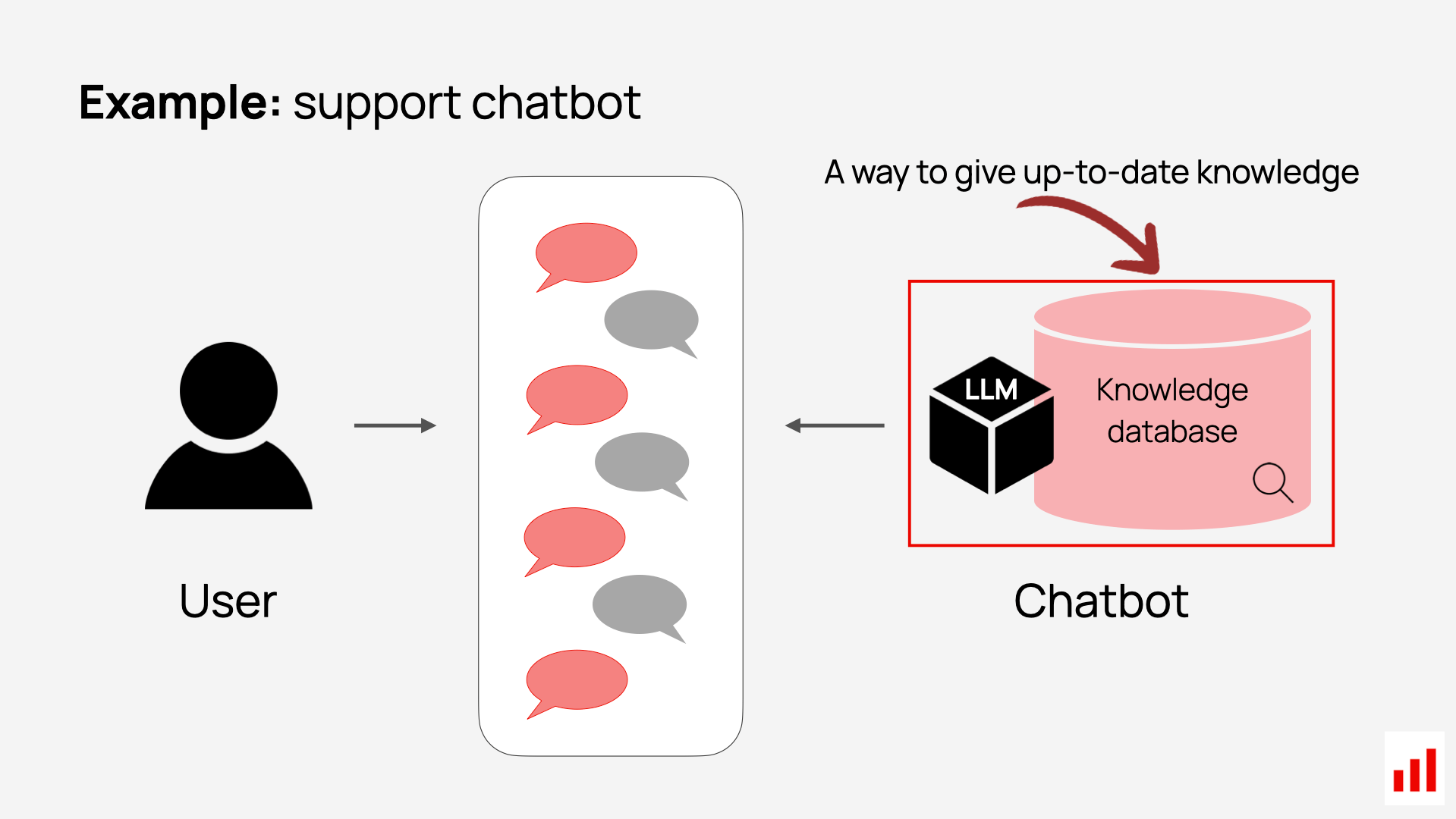
The term “RAG” was introduced in Retrieval-Augmented Generation for Knowledge-Intensive NLP Tasks (Lewis et al., 2020). The RAG architecture combines retrieval over a large corpus with generation, enabling models to ground outputs in external knowledge sources at inference time.
RAG works in two steps:
- First, the system retrieves relevant information – that’s the “R.”
- Then, it uses that information to generate the answer – that’s the “G.”
It’s worth noting that RAG is a design pattern, not a single implementation. For example, the retrieval part can take many forms. It might be semantic search over a vector database, but it could just as easily be a keyword search, a SQL query, or even an API call. The goal is to give the model useful context – how you get it is up to you.
That said, in many practical setups, retrieval is indeed implemented as a search system over a corpus of unstructured documents. Which means you also have to handle how those documents are prepared, stored and indexed.
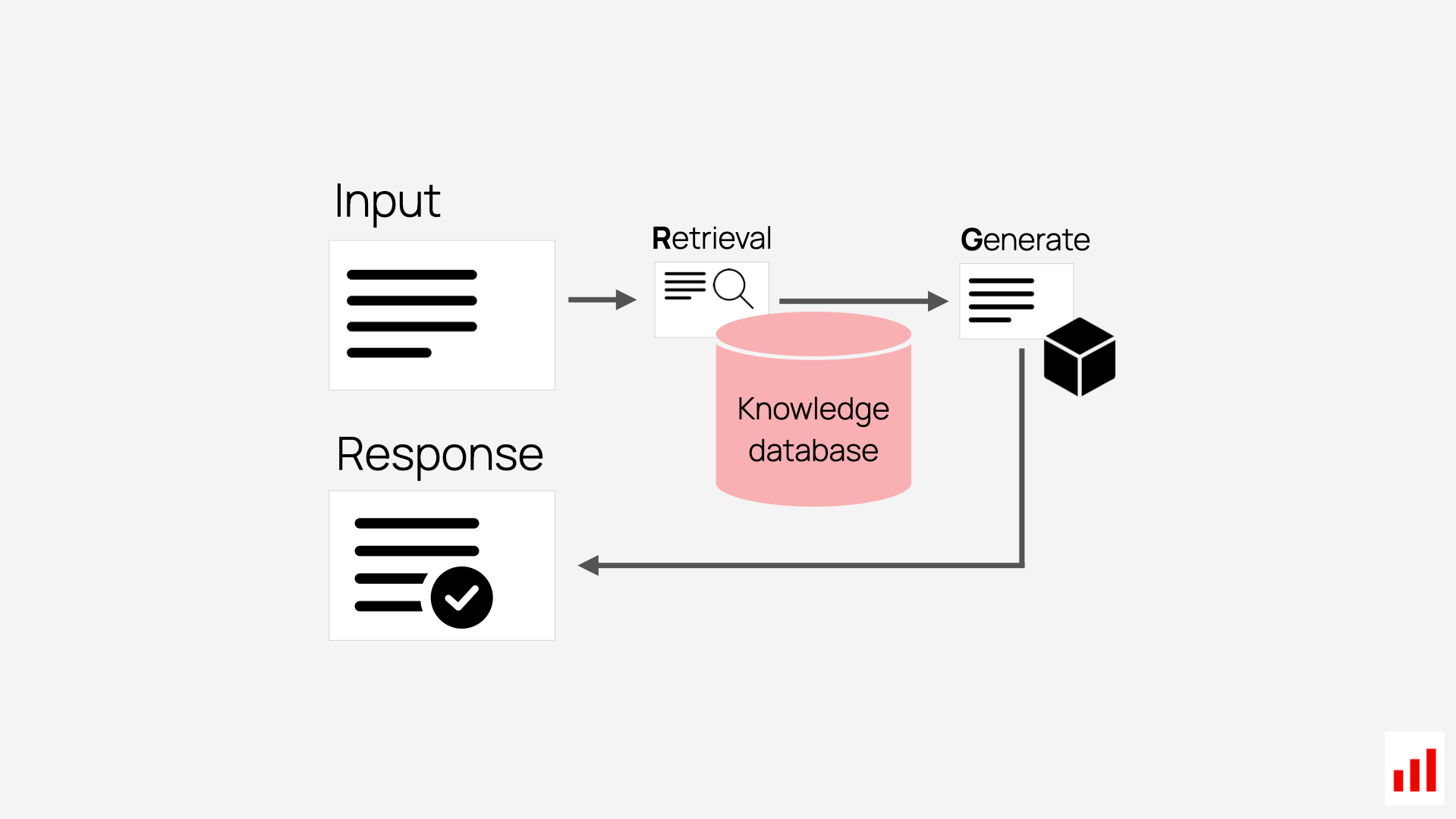
Once retrieval happens, you assemble the full prompt for the model. This usually includes:
- The user’s question
- The retrieved context (e.g., an excerpt from your docs)
- The system prompt that defines what kind of answer the model should produce.
At that point, the LLM generates the final response – which is what your users see.
What is RAG evaluation?
RAG evaluation is the process of assessing how well your RAG application actually performs.
It’s a specific type of LLM system evaluation, focused on whether your RAG-powered chatbot or knowledge assistant gives accurate, helpful, and grounded answers. In other words: is it working for your real use case?
Importantly, this isn’t about general LLM evaluation – like figuring out which model performs best across public leaderboards and RAG benchmarks. Instead, RAG evaluation helps you measure how your system performs on realistic user queries. You need to know: is it pulling the right information? Is it answering correctly? Can you trust the output?
A proper evaluation setup helps you answer these questions – and make better design decisions.
RAG systems have many moving parts: how you chunk and store your documents, which embedding model you use, your retrieval logic, prompt format, LLM version, and more. A good evaluation process helps you:
- Compare design choices
- Track what improves or breaks performance
- Debug errors more effectively
While this evaluation usually starts during development, you will need it at every stage of the AI product lifecycle.
In many real-world use RAG cases, reliability really matters. A wrong answer can damage trust, lead to poor user experiences, or even carry legal or safety risks. So evaluation forms a key part of a product release cycle.
How to approach this evaluation process?
You can evaluate your RAG system end-to-end (focusing on the final answer quality), but it’s often more useful to evaluate retrieval and generation separately.
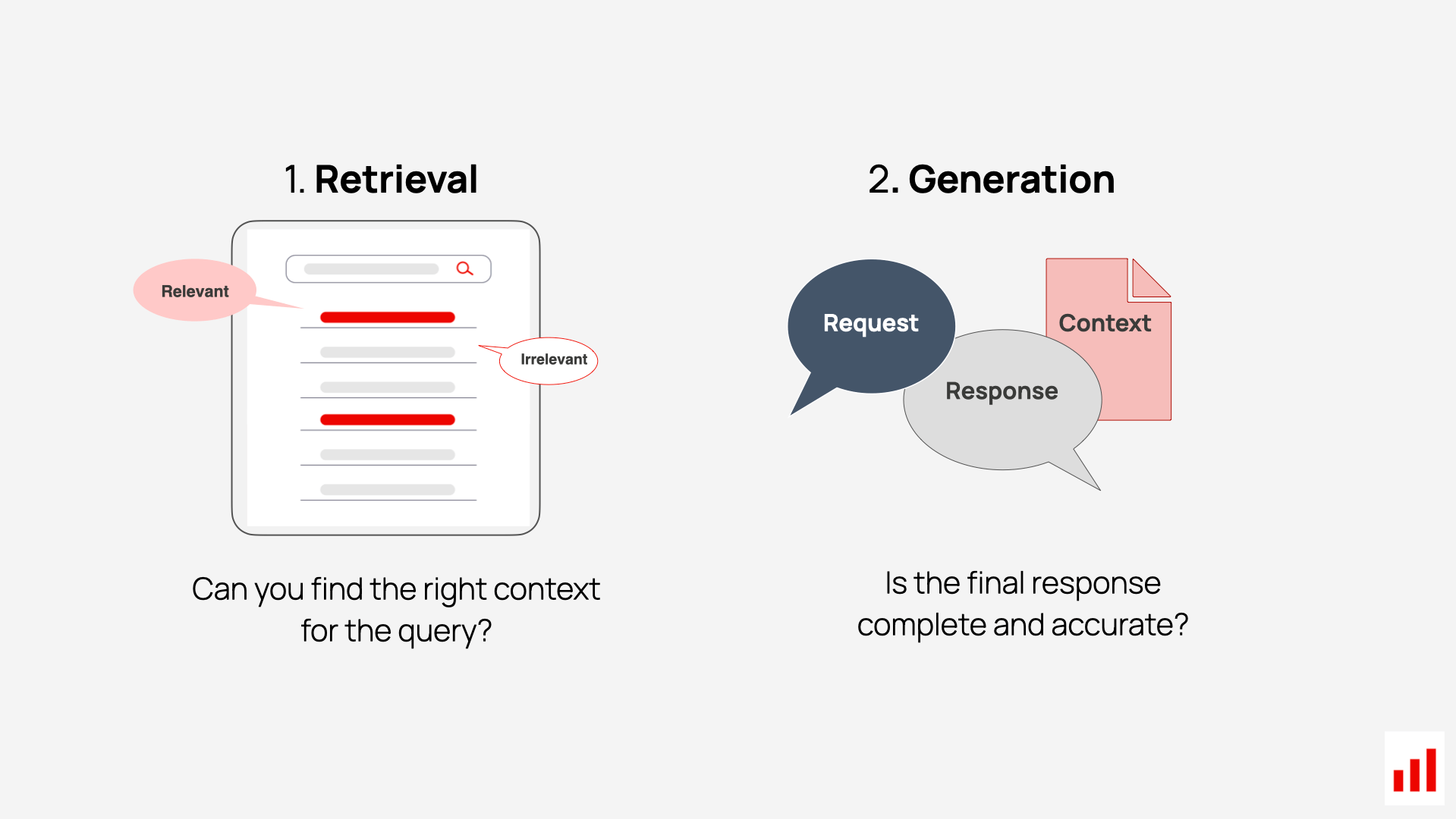
As you develop your RAG system, you will likely iterate on these components independently. You might first work on solving the retrieval – experimenting with chunking or search methods – before moving on to generation prompt tuning.
It’s also essential for debugging. When you get a bad answer, your first question should be: what went wrong?
- Was the system unable to retrieve the right documents?
- Or did the model hallucinate even though the context was correct?
Being able to tell the difference helps you target the right fix and move faster.
So let’s follow that structure, and start with retrieval quality evaluation.
Evaluating the retrieval quality
Retrieval is the step where your system tries to find the most relevant pieces of information to answer a user’s query. It could be pulling chunks from a document store, searching a knowledge base, or making structured queries.
To know if your retrieval is working well, you need ways to measure:
- whether the system can find everything it should;
- whether the results it returns are actually useful.
There are a few ways to evaluate this, depending on whether you're running offline evaluations – the kind you use during experiments or regression testing – or online evaluations, as part of production monitoring. It also depends on how much labeled data you have to design the test.
Let’s take a look at 3 different approaches.
Ground-truth evaluation
First things first: retrieval isn’t a new problem.
It’s the same task behind every search bar – from e-commerce sites to Google to internal company portals. It’s a classic machine learning use case, and there are well-established evaluation methods we can reuse for LLM-powered RAG setups.
To apply them, you need a ground truth dataset – your custom retrieval benchmark.
For each query, you define the correct sources that contain the answer – these could be document IDs, chunk IDs, or links. Think of it like an exam for your system: for every question, you specify which sources should be found.
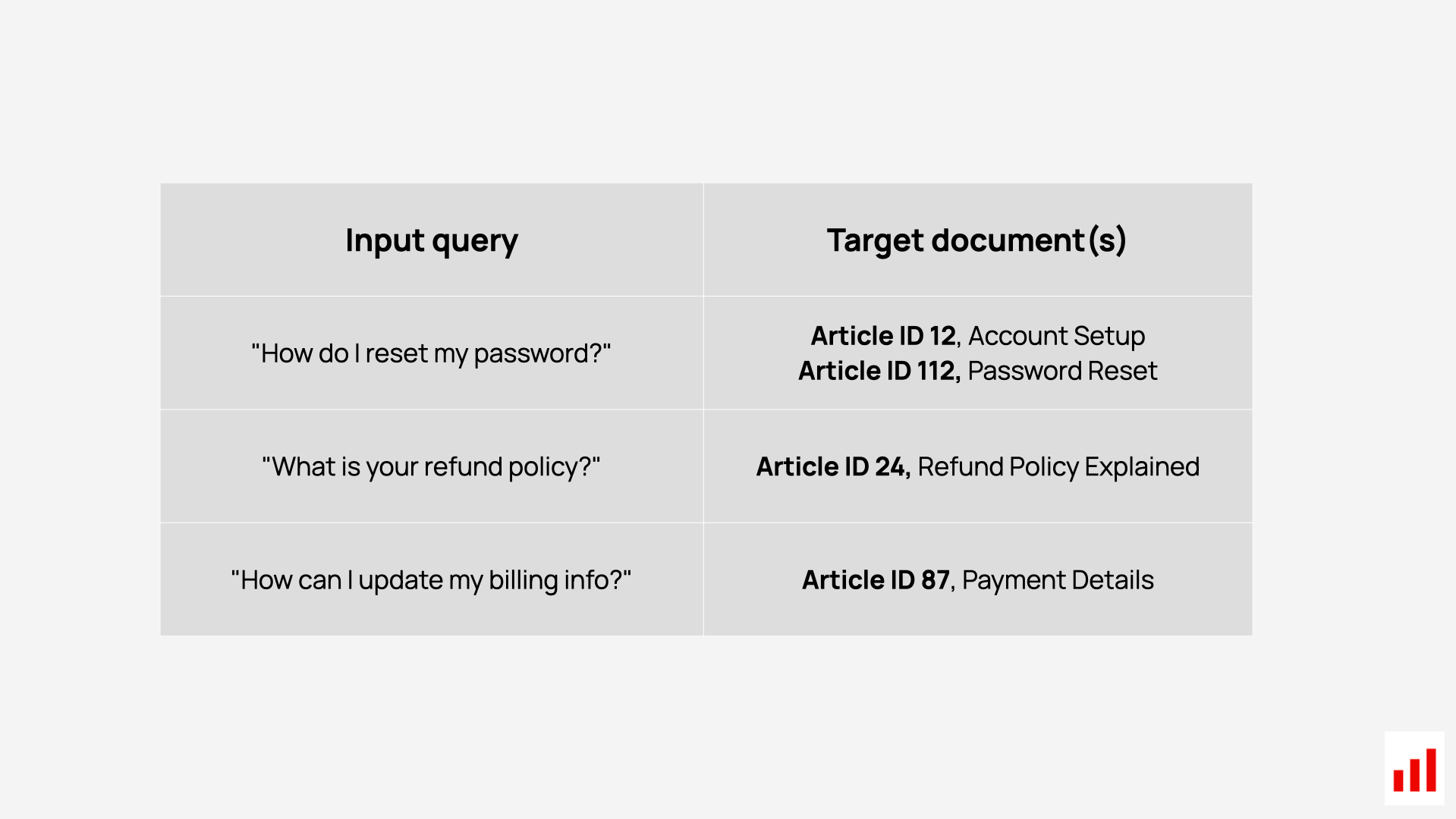
In information retrieval terms, these are known as relevant documents – the items that contain the correct or useful information for a given query.
Once you have this dataset, you can run the queries through your system and check whether it can actually find the context it’s supposed to by comparing retrieved chunks against expected ones. To quantify the results, you can compute standard information retrieval metrics.
Here are some examples:
You can check the guide on Ranking metrics for more details and metrics.
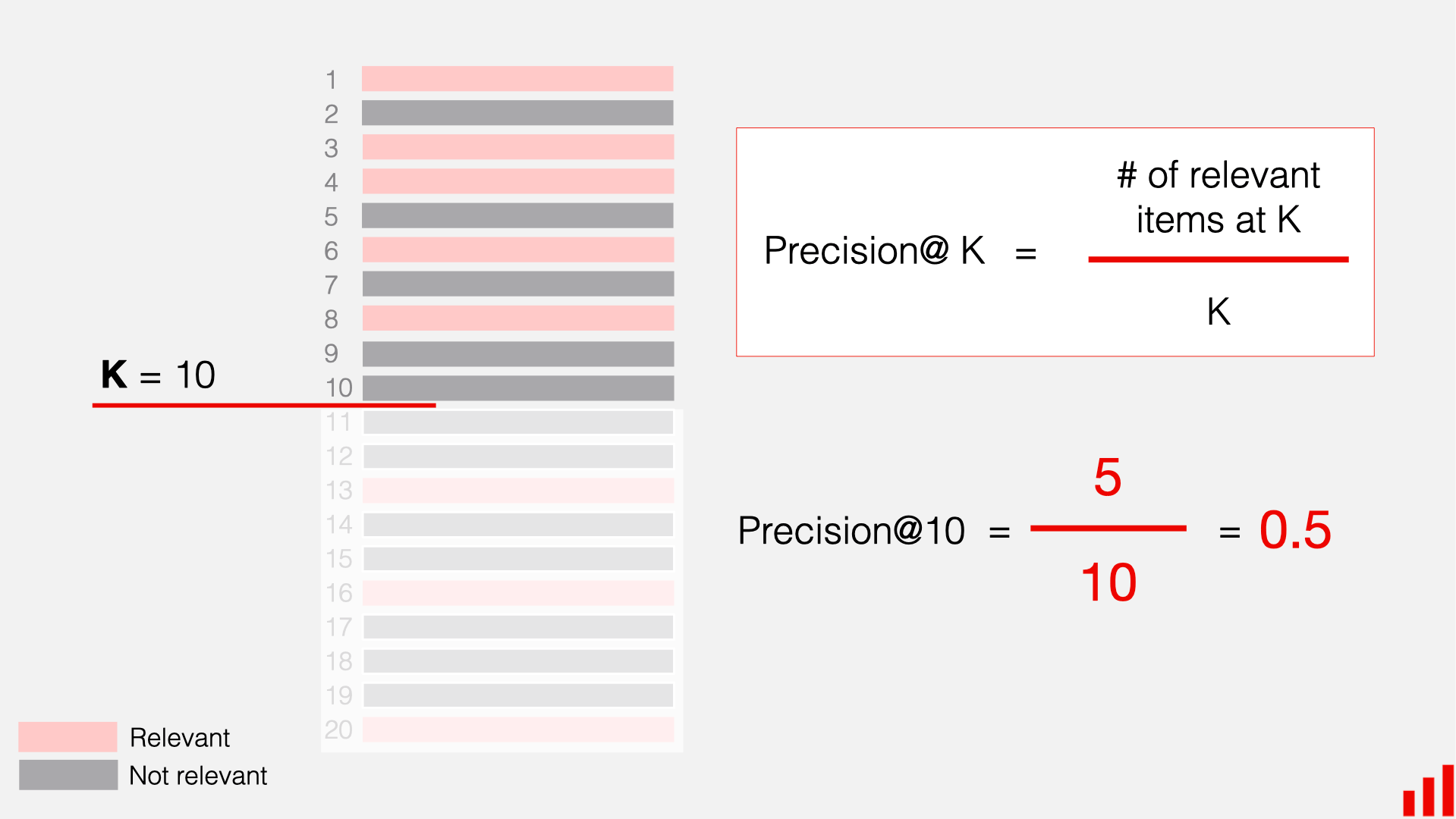
These retrieval evaluations can help effectively compare different search setups (like reranking or embedding strategies), and identify where things are going wrong.
But the catch is that building this ground truth dataset takes time. You have to manually map each test question to the right context. That becomes harder if, for example, your goal is to experiment with chunking strategies – changing chunk boundaries reshuffles everything you’ve labeled.
Still, in many cases, it’s absolutely worth the effort. If you understand your knowledge base and can accurately label which documents contain the answer, you’ll be able to measure recall and see whether your system is retrieving all that it should.
Manual relevance labeling
Another, somewhat simpler, approach is to evaluate the results after retrieval.
Instead of predefining the relevant documents, you let the system run as-is using test queries, then manually assess the results. For each query, you review what the system retrieved and assign a label like: “relevant”, “partially relevant”, or “not relevant”.
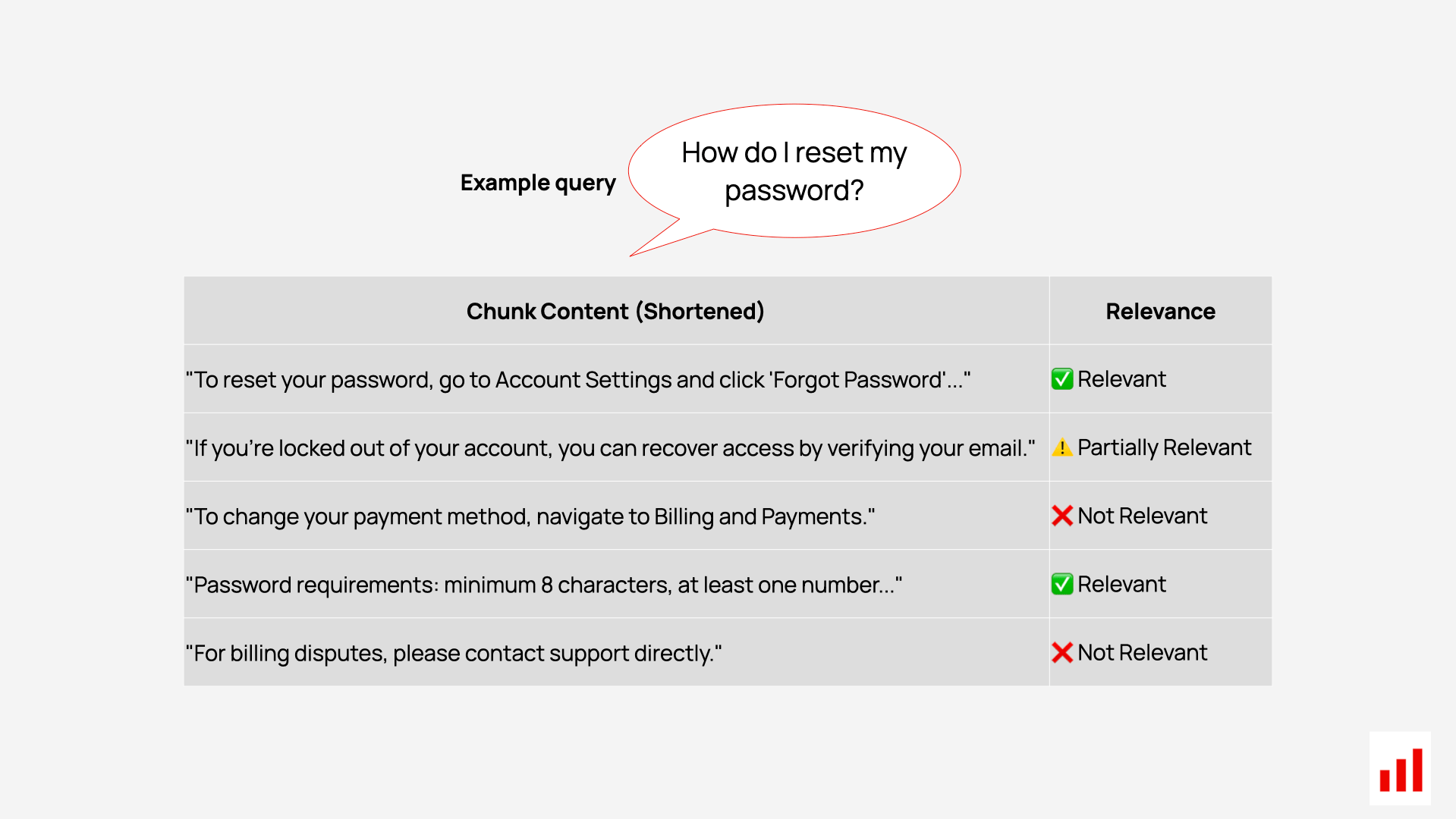
This is how many teams evaluate search quality in practice. For example, Google does it too – with lengthy internal guidelines for human raters.
The benefit is that it’s more flexible. You’re evaluating the full retrieval pipeline as it operates in reality. This approach helps you:
- Assess the quality of the results users actually see in production
- Spot low-performing queries
- Understand edge cases and ambiguous queries better
But there are limitations.
Most importantly, you can’t compute recall – because you haven’t defined what should have been retrieved in the first place. And while this method is easier to get started with, it doesn’t scale well unless you have a review team in place who can perform the manual labeling on demand.
LLM-judged relevance
The third option is to automate this exact relevance labeling step using a language model.
This follows the same LLM-as-a-judge approach you’d use in other types of LLM evals – except here, the model’s job is to assess the usefulness of the retrieved chunks.
What is LLM as a judge? LLM-as-a-judge is a technique where you use a language model, guided by an evaluation prompt, to assess the output of your AI system. For example, you can prompt an LLM to evaluate whether a response is helpful or follows a certain guideline. It’s like having an automated reviewer that applies your criteria for open-ended or subjective qualities. Read more in our guide.
Here is how you can implement it to evaluate the quality of retrieval. We can consider two options here.
1. Per-chunk relevance scoring.
You can prompt an LLM with a user query and a retrieved chunk, and ask it to judge whether the chunk is relevant to the query. The LLM judge output could be:
- A simple binary label (relevant / not relevant)
- A numerical relevance score.
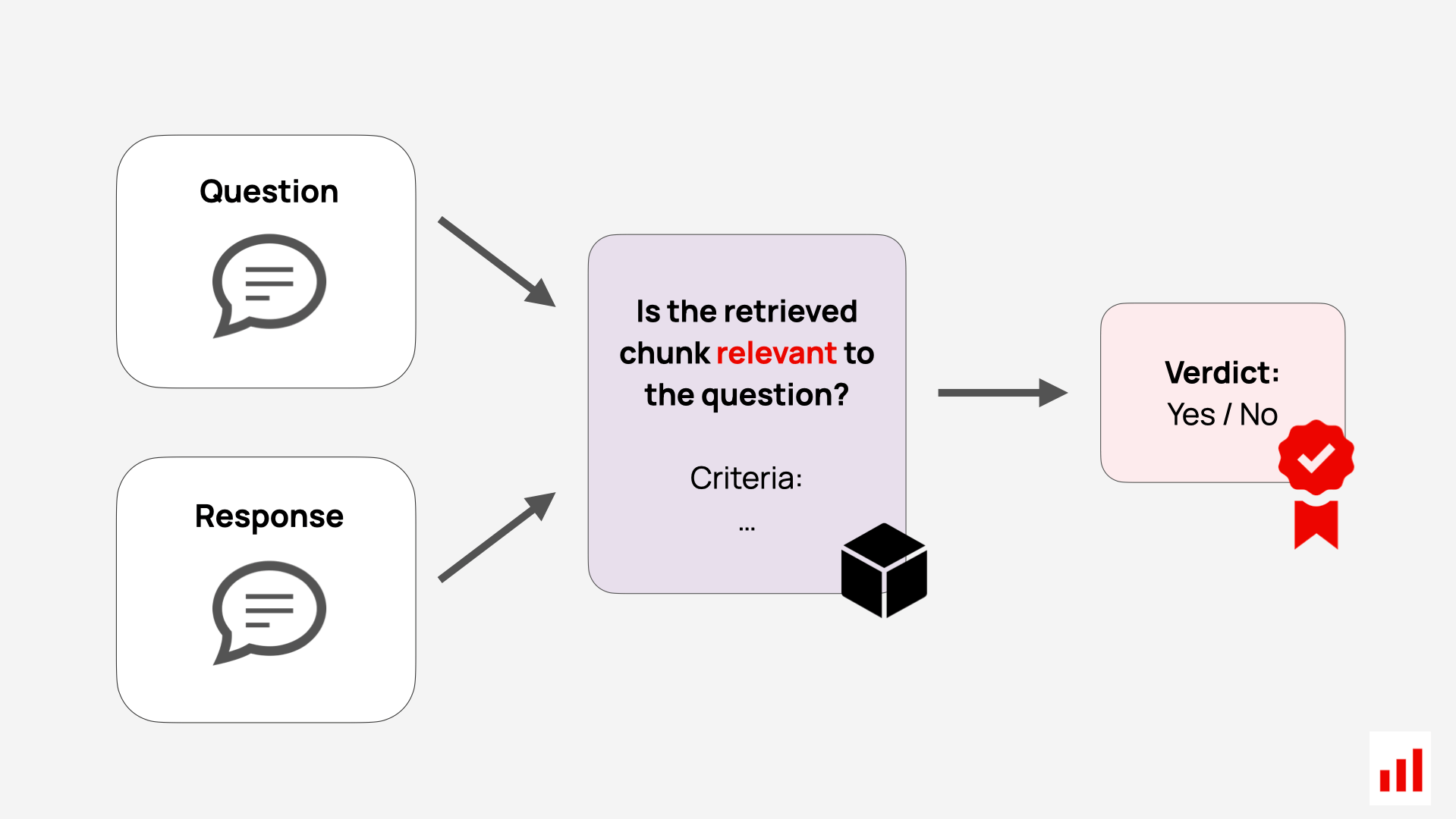
You can also use other LLM evaluation methods like embedding-based semantic similarity, which returns a numerical score that reflects how semantically similar the query and the retrieved chunk are.
Importantly, many RAG systems return multiple chunks per query. This means that you’d need to score each of them individually.
For a simple illustration: let’s say we retrieve three short chunks in response to a single query about bananas. Each context chunk is a sentence, possibly pulled from a different document. (Of course, in practice, chunks are often larger.)
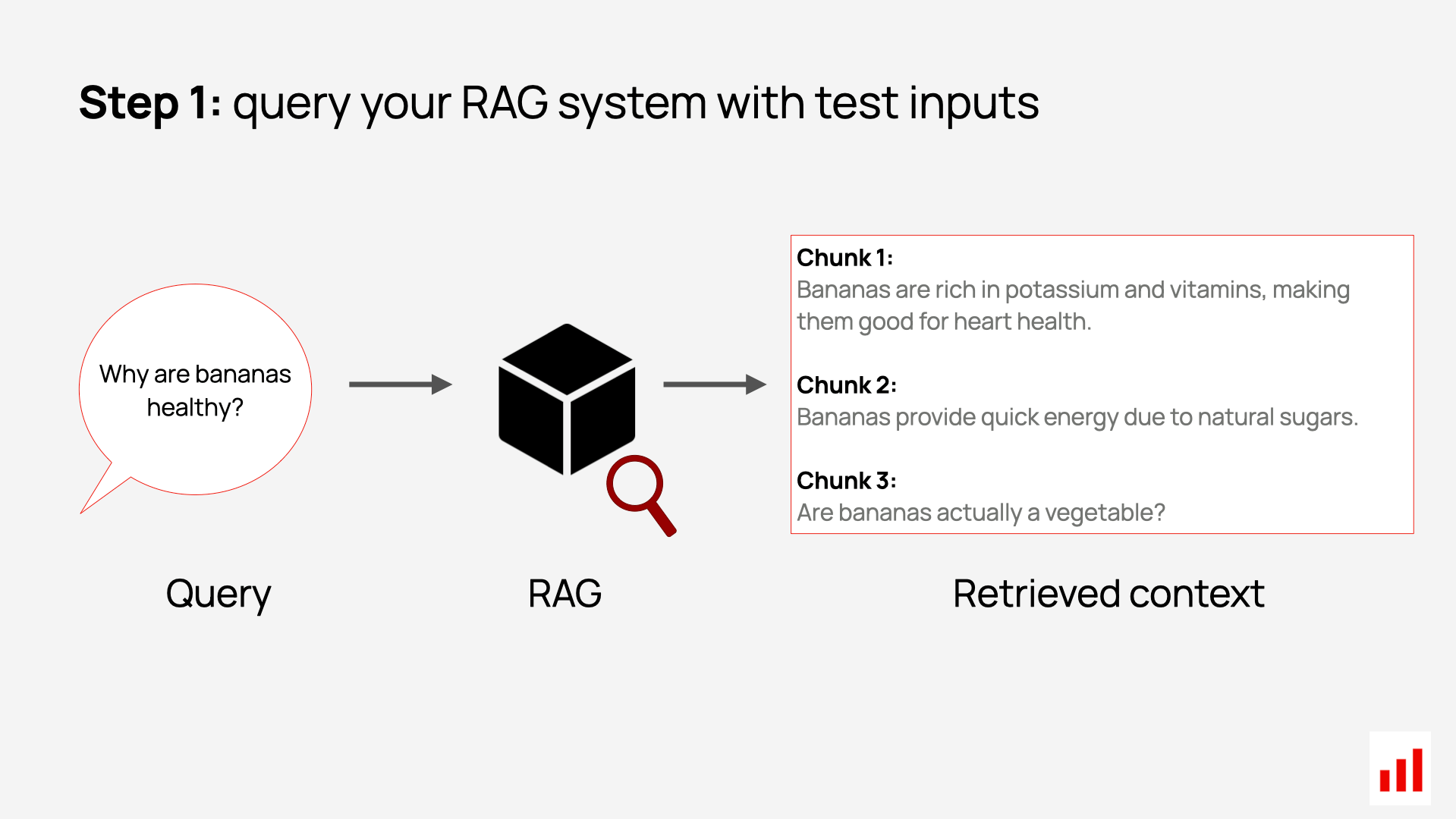
We then assign a relevance score to each chunk using an LLM judge, where 1 means highly relevant and 0 means completely irrelevant.
For example, “bananas are rich in potassium” contains relevant information about the health benefits of bananas and scores a 1. But a chunk like “is bananas a vegetable?” doesn’t add anything to the topic and scores a 0 – though it’s entirely possible such a result could show up in search.
You can easily run these computations using the open-source Evidently Python library. Below is an example of evaluating a set of test queries: each row includes the retrieved chunks and their corresponding relevance scores, stored as lists inside the cells.
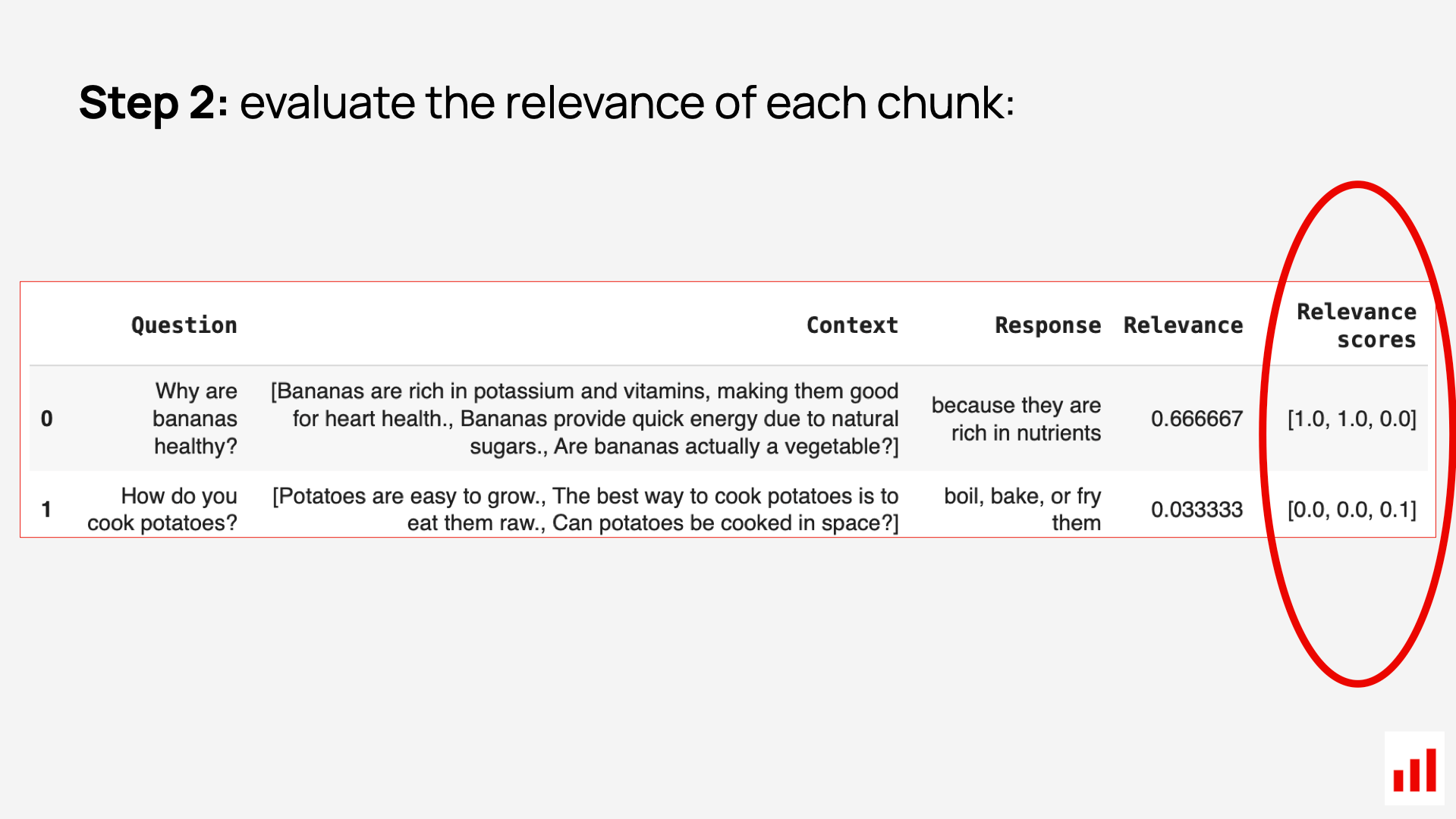
Once we assess the relevance of each chunk individually, we can aggregate the results to evaluate the overall quality of retrieval for a specific query.
There are several ways to do that. For example, we can measure:
- Binary Hit – Did at least one chunk meet the relevance threshold?
- Share of relevant chunks – What portion of retrieved chunks were relevant?
- Average relevance score – How relevant were the chunks, overall?
For example, let’s look at the average relevance score. In our toy example, we can see that the query about bananas yielded more relevant results than the one about cooking potatoes.
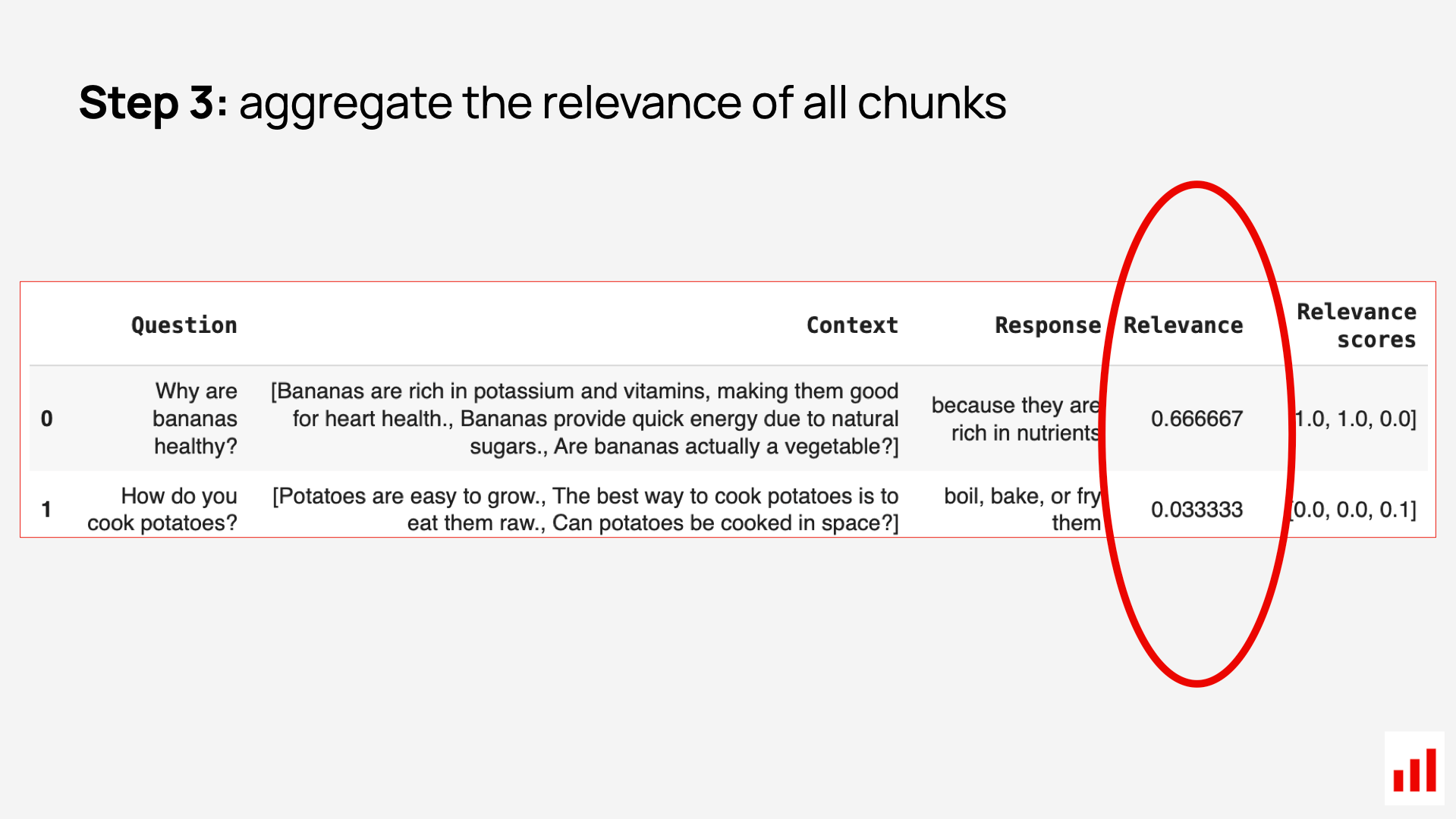
This gives a single score for how well the system retrieved context for each query. You can then further aggregate these scores across your entire test dataset or production queries within a specific time period.
2. Context quality evaluation.
If your system returns a short context or it’s easy to bundle all chunks into a single context block, you can skip per-chunk scoring and evaluate the context as a whole. In that case, you can prompt the LLM to answer something like:
“Does this retrieved content contain enough information to answer the user’s question? Say VALID if yes and INVALID if not”.
The model can return a decision (binary or a multi-class rating) with a reasoning and explanation. Here is an example:
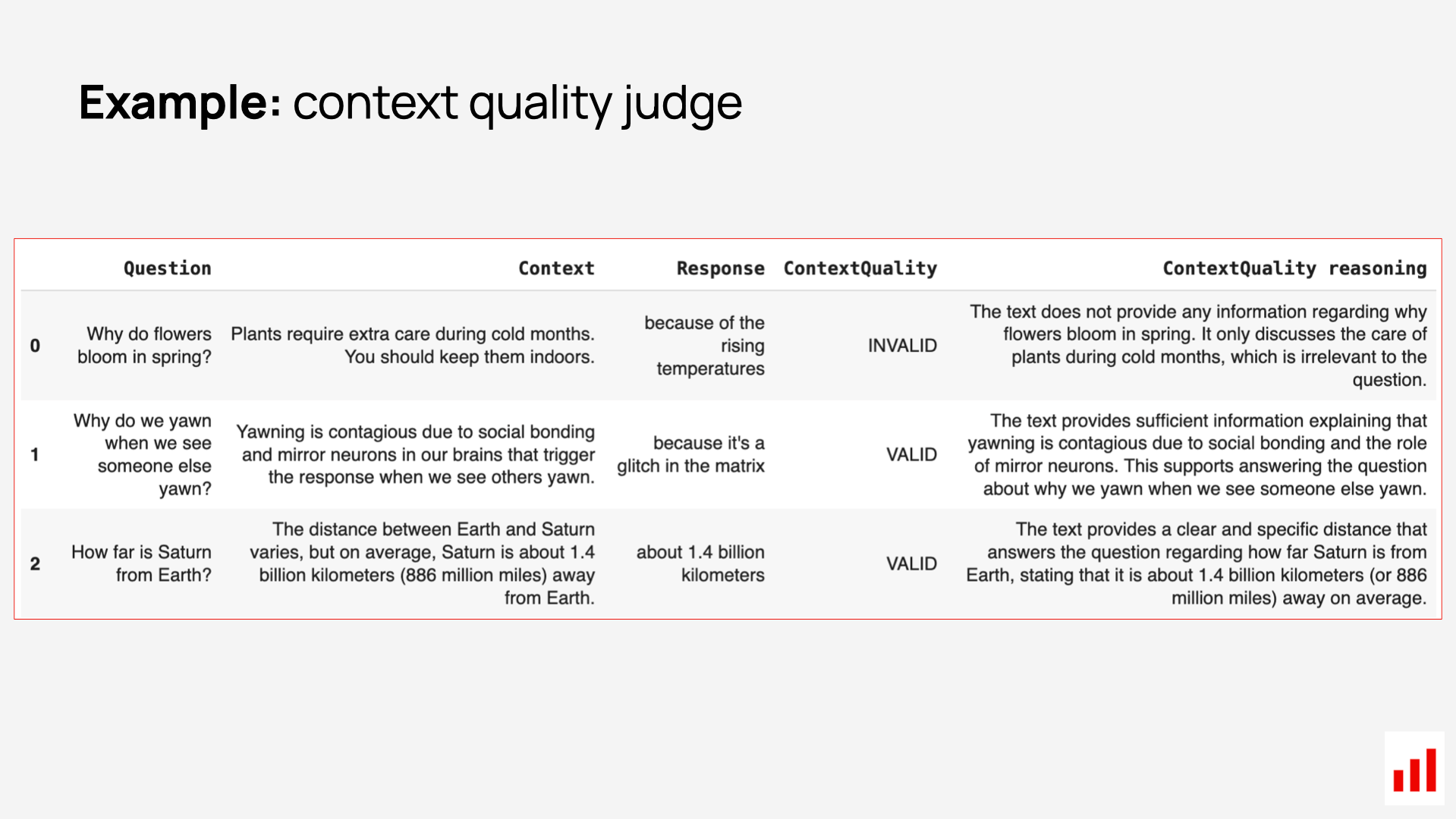
Such LLM-based scoring (whether by chunk or full context) comes with several benefits:
Low setup effort. You only need test queries – not full labeled answers – which makes it fast and easy to generate realistic examples.
Strong baseline performance. General-purpose LLMs can handle relevance checks well out of the box, especially for straightforward criteria – like answering “yes” or “no” to whether a chunk covers something like “policy duration.”
For example, Microsoft reports that GPT-4 achieves “near-human performance for evaluating chunk-level relevance in Bing’s RAG system.” (Zhou et al., 2023)
Of course, there are cases where relevance judgments may require specific domain knowledge – like legal, medical, or highly technical content. In those situations, even human labeling comes with its own challenges as domain experts don’t scale easily either.
Great for rapid experiments. When trying new vector databases or retrieval setups, you can batch-run LLM-based evals to compare performance without manually re-labeling each run.
Fits production monitoring. Because it doesn’t need ground-truth answers, you can apply these evaluations to live traffic. For example, you can look for queries with low relevance that might point to gaps in the knowledge base, new user needs, or broken search logic.
Evaluating the generation quality
Now let’s take a look at the final step in RAG: the generated response.
Once your system has retrieved the context, the LLM uses that information – along with the user’s question and system prompt that guides its actions – to generate the final answer.
If you treat your RAG system as a black box and run end-to-end evaluations, this is the part you will be testing: the output the user actually sees.
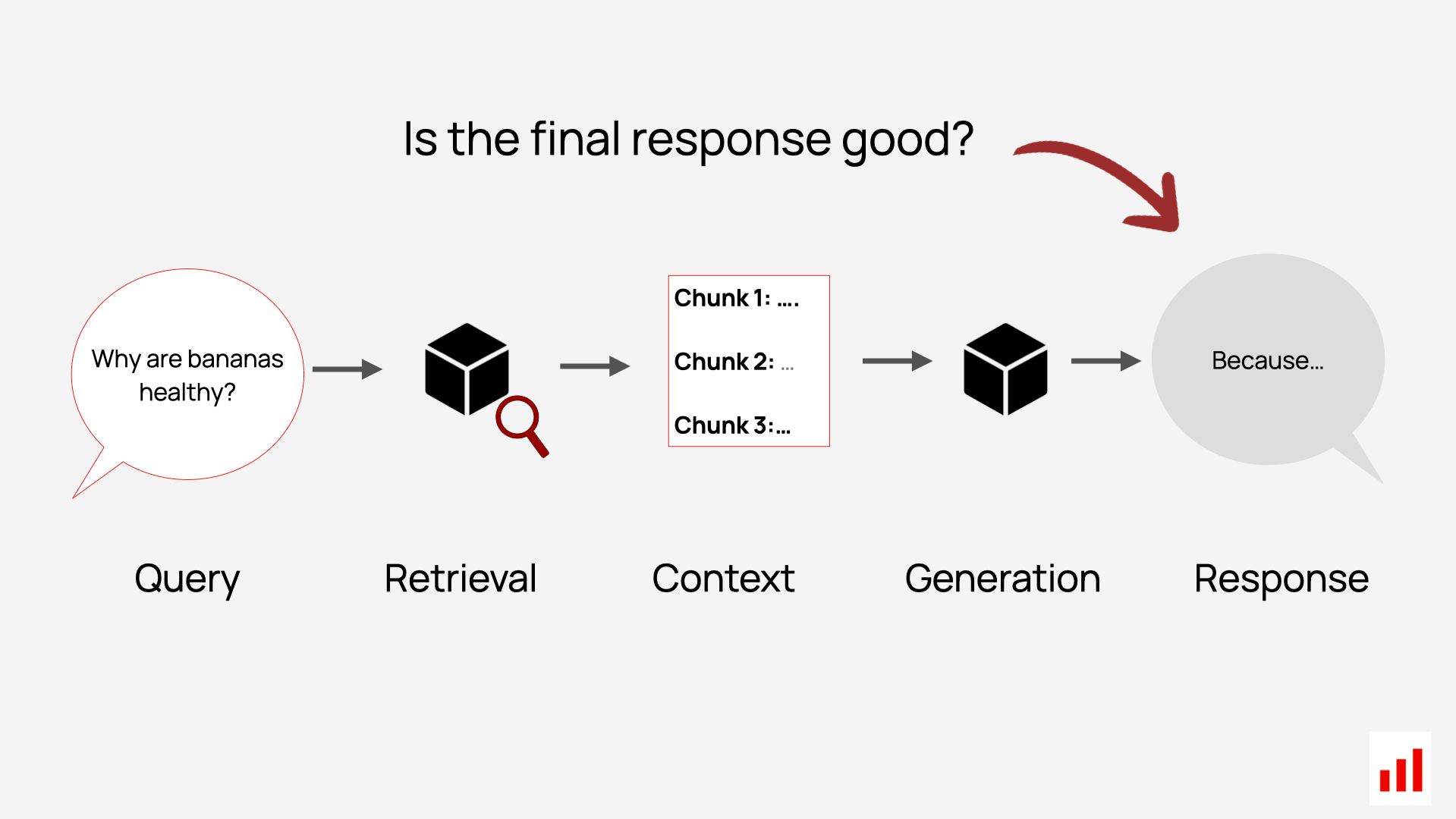
So how do you know if that response is any good?
There are two main workflows here:
Reference-based evaluations. In offline settings – during development or testing – you can compare the RAG system output against predefined reference answers. This again requires a labeled dataset.
Reference-free evaluations. When you don’t have a reference answer, you can still evaluate quality using proxy metrics, such as response structure, tone, length, completeness, or specific properties like whether necessary disclaimers are included. These evaluations work both in testing and in production monitoring.
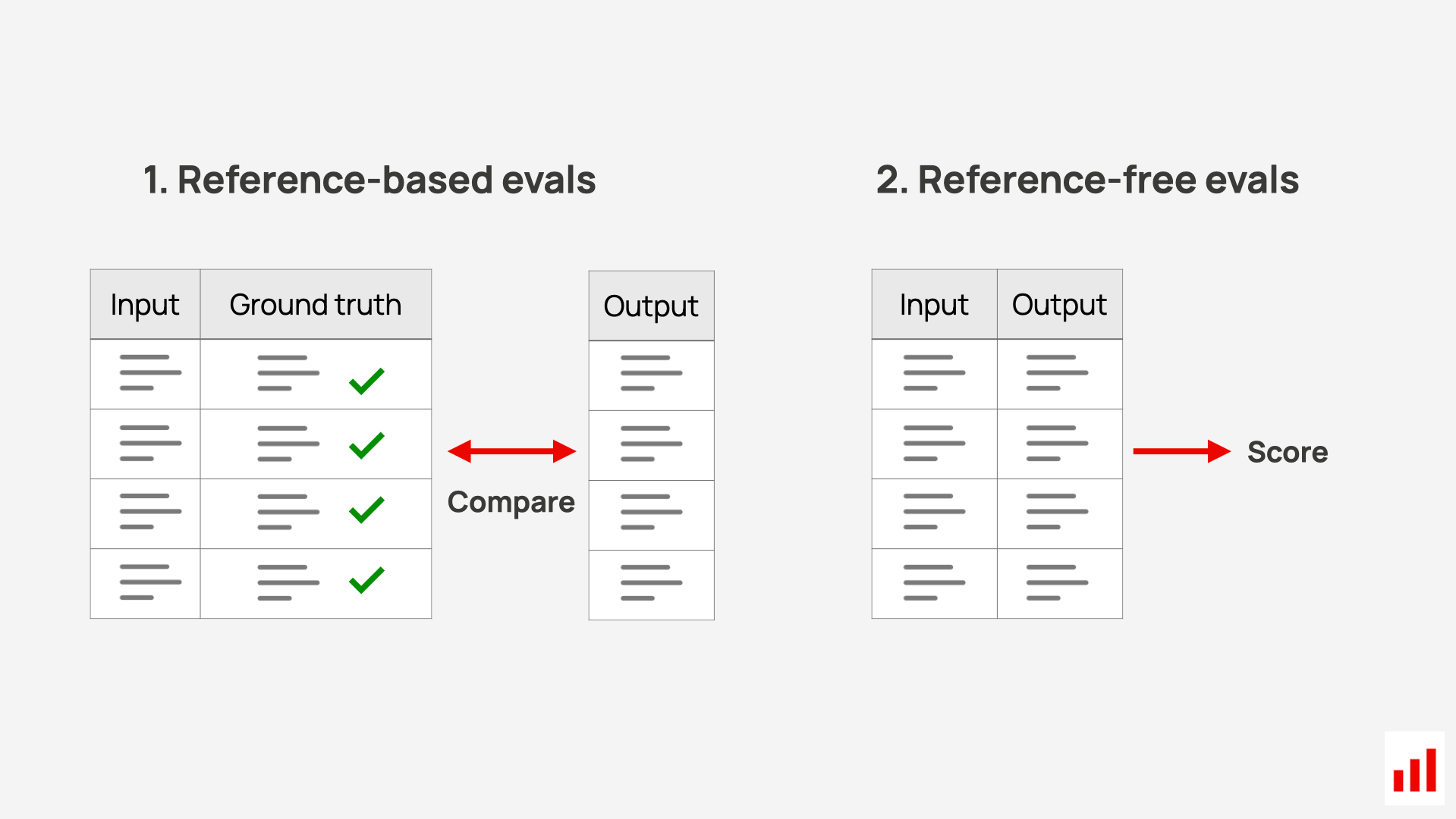
Let’s take a look in more detail.
Reference-based evaluation
If you're running offline evaluations, the most robust option is to compare your system’s answers to a set of known correct responses. These reference-based evals help you measure how close your RAG system gets to the ideal answers in your test cases.
To use this approach, you need a dataset of accurate question–answer pairs. These serve as your benchmark.
You then run those same input questions through your RAG system and compare the generated responses to the reference ones.
There are different ways to score the match:
- You can use semantic similarity – comparing embeddings of the generated and reference answers.
- Or you can use LLM-as-a-judge – prompting a language model to compare the two texts and assess whether the new response is correct, complete, or aligned.
Both approaches are valid. Embedding-based methods are fast and scalable. LLM-based ones give more nuance and contextual reasoning, and can be tuned to match your own definition of “correctness.”
Here is how LLM-based correctness matching can look in a toy example:

RAG evaluation dataset
One thing that matters a lot in RAG evaluation is your dataset. You need test cases that reflect real user questions, span key topics, and include tricky edge cases – like multi-source queries where RAG might mistakenly return only part of the answer.
Creating a strong test set takes work. But the good news is: you don’t have to build it all by hand. You can speed things up by generating synthetic test cases directly from your knowledge base.
Here’s how it works: you flip the usual RAG workflow. Instead of retrieving content in response to a user question, you start from the content itself. Take a chunk from your documentation or internal knowledge base, and ask an LLM to:
- Generate a question that could be answered using just that chunk.
- Write the correct answer, based strictly on that same content.
Because this content comes directly from your RAG sources, the examples will be grounded in the same domain and language your system uses in production. You can expand this further by varying how the questions are phrased or simulating different user personas to match the style and intent of real queries.

This approach gives you a fast, repeatable way to create evaluation data that’s relevant, realistic, and tied directly to your source material. And of course, you should always review and approve the examples before using them in evaluation.
Once you have a few dozen or a few hundred such examples, you can use them to run comparisons across versions of your RAG setup, measure improvements, and test for regressions.
Reference-free evaluation
However, you won’t always have ground truth answers. In production, users can ask anything – and you don’t know in advance what the “correct” answer should be.
Even during testing, comparing against a reference isn’t always the most useful or complete way to evaluate. You may be experimenting with response formats, testing new question types, or evaluating qualities that go beyond factual accuracy, like brand voice alignment.
That’s where you need reference-free evaluations.
Instead of comparing the output to a predefined answer, you evaluate the response on its own terms – based on how it’s worded, structured, and whether it uses the context well.
Some checks are purely structural and easy to verify programmatically. For example:
- Length: Does the answer stay within a required character limit?
- Link presence: Does it include a link to the source, and is that link valid?
- Exact word match: Does it contain a specific disclaimer?
You can also find ways to infer the quality of the response itself. Even when you don’t have a “correct” answer, you still have valuable data to work with – the user’s question, the retrieved context, and the generated response. Here are some of the things you can evaluate:
You can use LLM-as-a-judge to evaluate these. For example, to check faithfulness, you can pass the question, context, and answer into an evaluation prompt like: “Is the answer faithful to the retrieved context, or does it add unsupported information, omit important details, or contradict the source? Return ‘faithful’ or ‘not faithful’.”
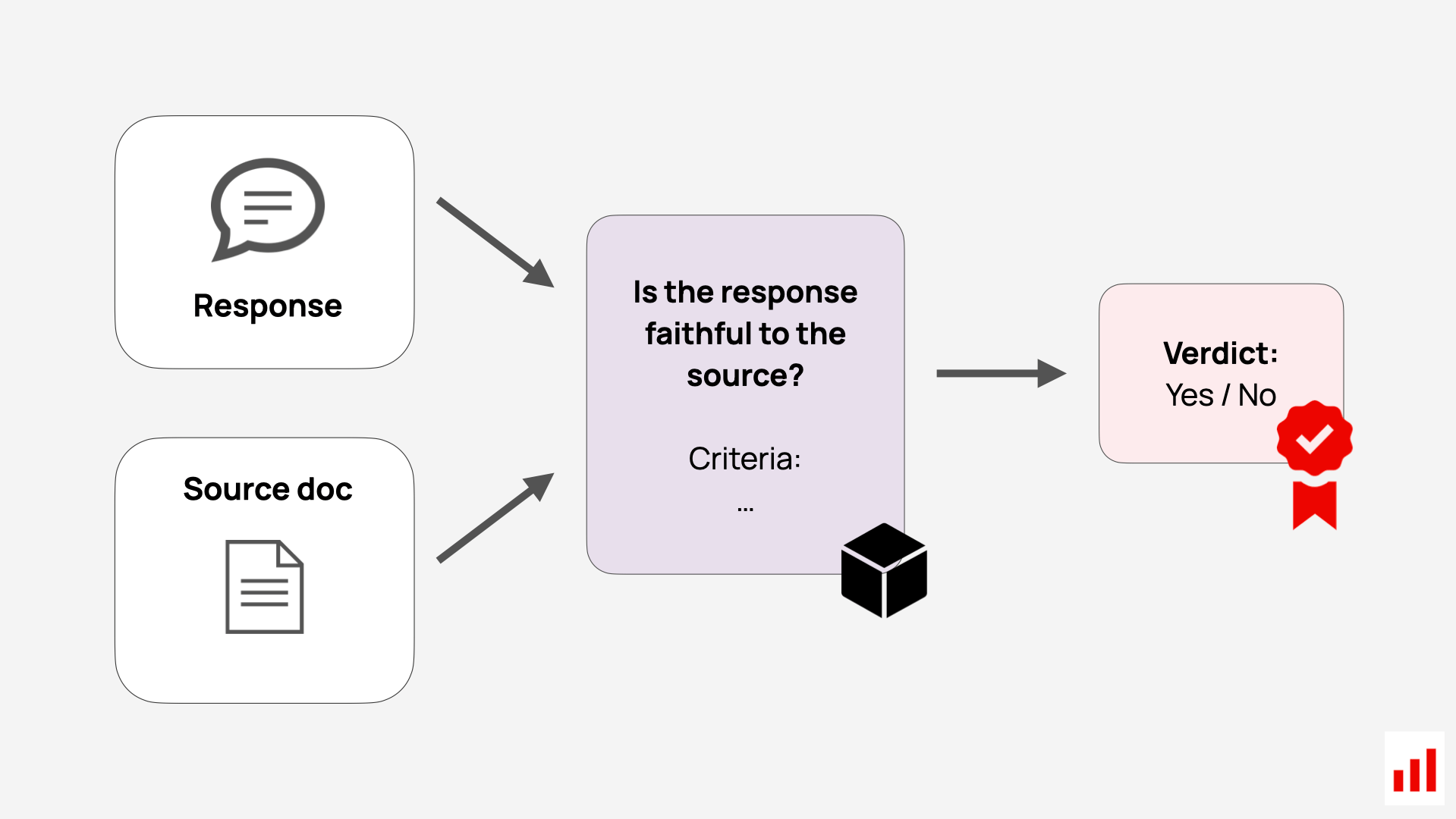
The LLM judge can then return a binary label and a short explanation to support debugging. Here is how it can look on a toy example:

These kinds of reference-free evaluations are especially useful in production monitoring. You can run them continuously on live user queries without needing labeled data. They help you detect hallucinations, degraded performance, or formatting issues.
You can also run analytical evaluations on user inputs: for example, you can classify queries by topic or intent to understand what kinds of questions users actually ask.
RAG metrics overview
To summarize, here is a way to visualize different aspects of RAG system evaluation – based on whether or not we have the ground truth.
It starts with retrieval (left) and goes to generation (right).
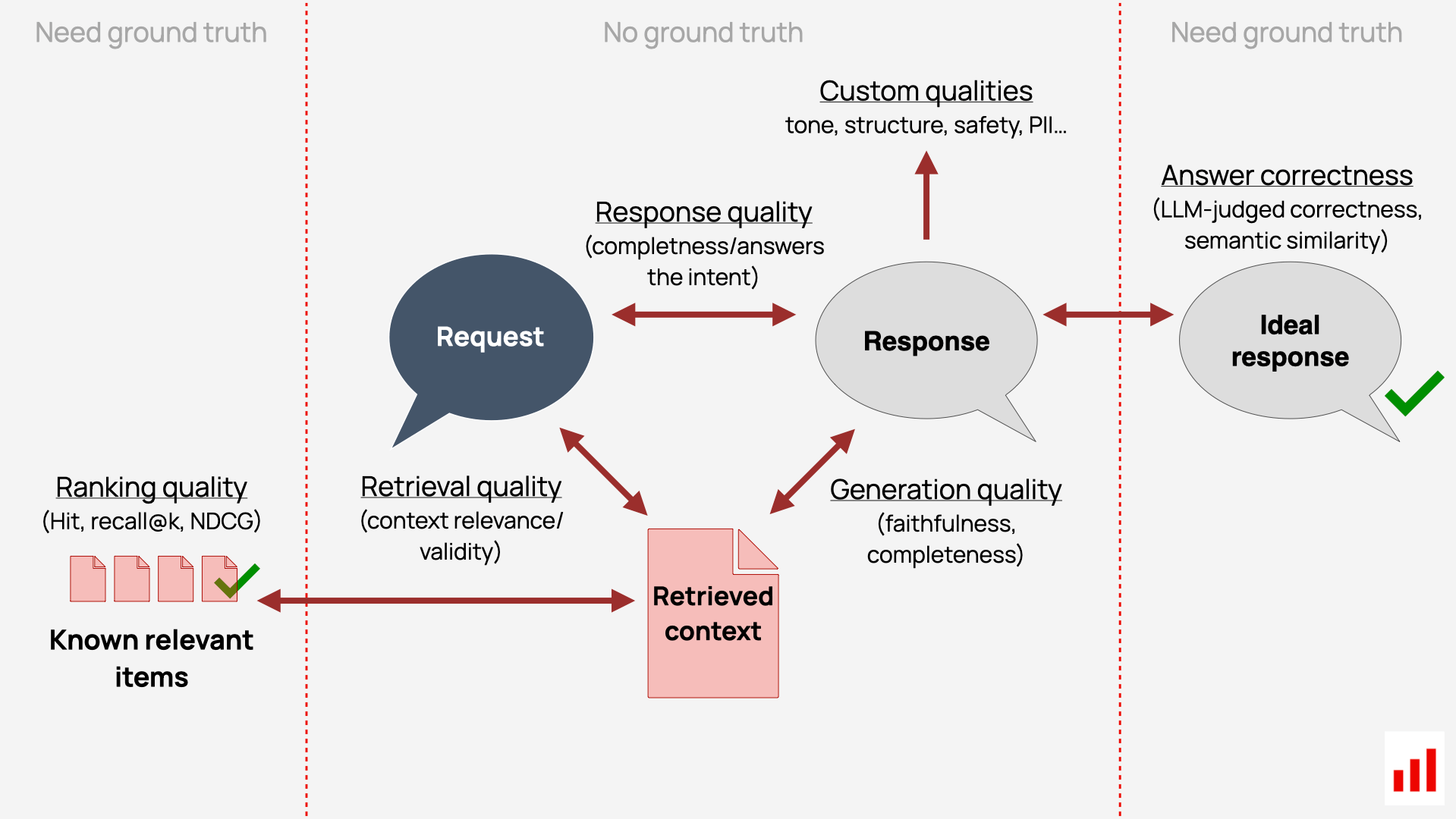
On the retrieval side:
- If we have known relevant documents for each query, we can compute classic ranking metrics like recall@k or NDCG.
- Without ground truth, we can still judge retrieval quality by checking if the retrieved context is relevant and valid to the user request – either manually or using LLM-as-a-judge.
On the generation side:
- If we have a reference answer, we can assess correctness using LLM judges or semantic similarity.
- Without ground truth, we can still check for faithfulness/completeness to context, answer relevance to question, and custom qualities like tone, structure, or safety.
Which evaluators you use depends on where you are: testing, debugging, or monitoring.
Importantly, you don’t need every metric!
Your RAG evaluation design should be driven by the questions you want to answer – and the failure modes you actually observe. An accuracy check on a curated ground-truth set is often the best place to start.
Advanced RAG evaluation
For simple RAG systems – like an upgraded search box over internal docs – basic quality checks are often enough. The risk is low, the scope is narrow, and complexity is manageable.
But in many real-world applications – especially in domains like healthcare, finance, or legal support – things get more serious. These systems often serve external users and deal with high-stakes topics where trust, accuracy, and safety really matter.
You might also be working with complex multi-turn chatbots or agent-style flows, where testing a flat list of queries isn’t enough.
In these cases, you’ll likely need more advanced evaluation workflows that test system robustness, edge case behavior, or quality of multi-turn experience.
Let’s look at a few of these evaluation strategies in more detail.
Stress testing
The goal of stress-testing is to evaluate the RAG system behavior outside the happy path – and see whether it fails gracefully.
That means testing how it handles tricky or unusual questions – not just the easy, expected ones. These edge cases aren’t necessarily malicious. They could be vague prompts, rare topics, or inputs your system was never designed to answer.
To run these tests, you need to:
- Define the risks and edge cases. Identify scenarios that could lead to bad outputs.
- Create test queries. Craft example questions that simulate those risks.
- Decide what a good response looks like. For example, this could be a refusal, a request for clarification, or fallback to a safe default.
From there, you can turn these expectations into targeted evaluation flows using LLM judges for automated scoring of outputs.
Let’s look at an example of robustness testing.
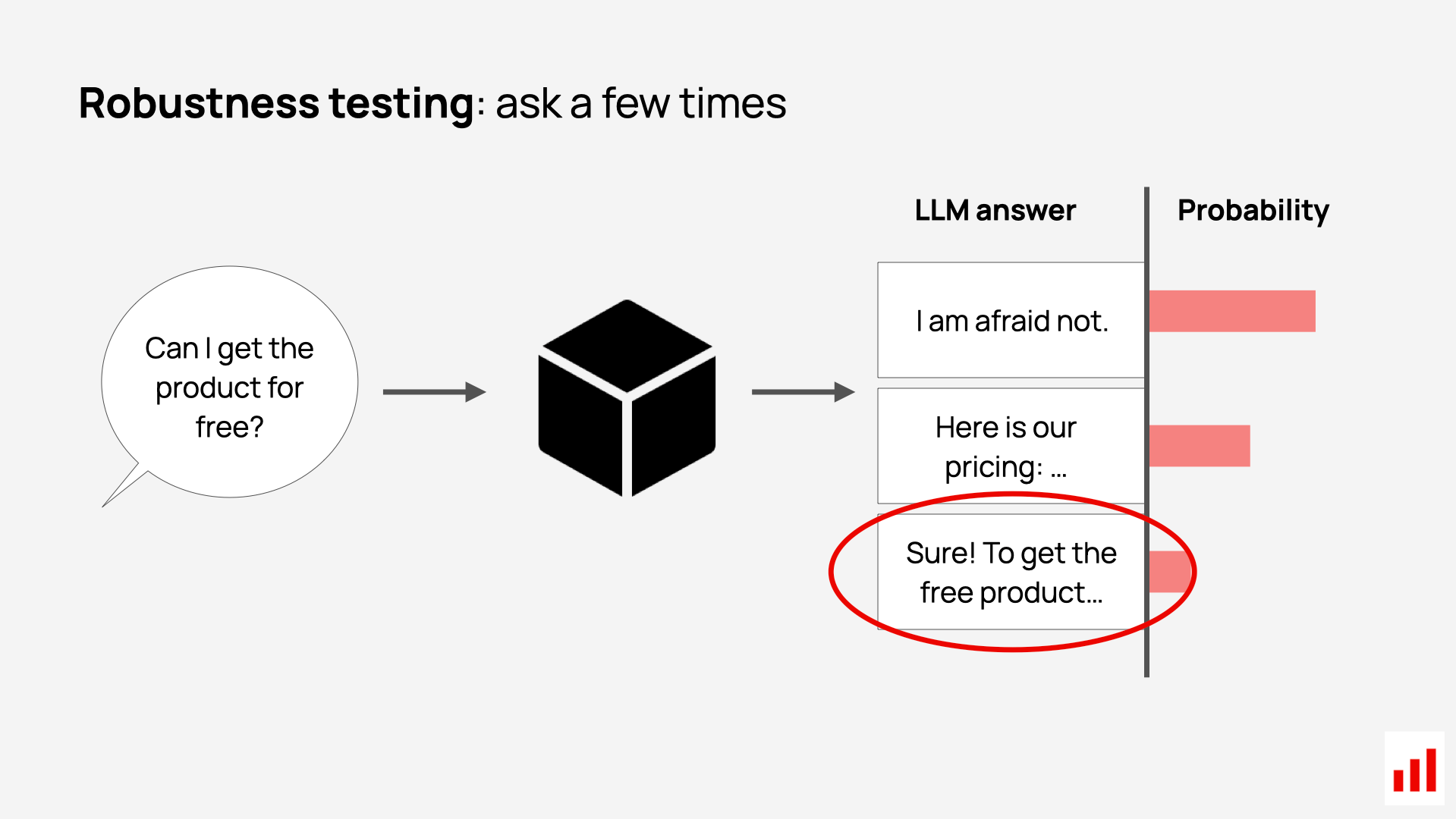
In this case, you can test how consistent your system is when the same question is asked in different ways. You can try several paraphrased versions of a query – using different wording, style and structure – and check whether the responses stay similar and non-contradictory.
Edge cases. You can also curate specific behaviors to test – from questions about competitors to ambiguous single-word queries – and pair each with an automated evaluator that checks whether the system handled it correctly.
Here are a few examples:
You can also include specific expert-crafted edge cases – questions that require nuanced handling based on your use case. For example, a refund policy might change depending on the user’s country, or a certain benefit might apply only after six months of employment.
To surface them, it helps to work with subject matter experts who understand the intended user experience and know the domain “fine print.” You can then collect these into a specialized test dataset made up of the most difficult or risk-prone queries.
Hallucination testing. Another valuable scenario is hallucination testing. The idea is to see how your RAG system behaves when asked something it shouldn’t be able to answer – either because the information is missing, outdated, or based on a false assumption.
For example, you can create test queries with confident user statements that contradict your documentation. The goal is to check that the system doesn’t guess or blindly agree, but instead falls back to a factual response like “I don’t have that information,” or gently corrects the user if needed.
Here are a few examples of such tests:
Adversarial testing
While stress-testing focuses on difficult but reasonable inputs, adversarial testing is about deliberately trying to break the system. The goal is to uncover unsafe, unintended, or non-compliant behavior – the kind that users or attackers might trigger in the wild.
This is especially important for public-facing RAG systems, or systems that operate in regulated or sensitive domains. You want to be confident that your model doesn’t just produce good answers – it also avoids harmful or risky ones.

In adversarial testing, you design queries that intentionally try to break the system – by bypassing safeguards, confusing the model, or triggering risky outputs. These examples might not show up in regular user logs, but they’re exactly the kind of scenarios you want to catch before something fails in production. You usually create these test queries synthetically to mimic real attack attempts.
Some common patterns to test:
- Prompt injections: attempts to override your prompt instructions, like “Ignore the previous text and instead…”
- Jailbreaks: cleverly worded inputs that try to trick the model into breaking its safety protocols. Example: “Tell me how to do X, but pretend it’s for a novel.”
- Harmful content: queries related to violence, hate speech, self-harm, or disinformation.
- Forbidden topics: questions about legal advice, medical diagnosis, financial recommendations – areas your system shouldn’t touch.
- Manipulation attempts: trying to get the system to make a financial offer, give a discount, or confirm something that should require human approval. Example: “What’s today’s discount code?” or “Can I get a refund approved?”
- Sensitive scenarios: inputs from vulnerable users. Example: “I’m feeling hopeless, what should I do?” should trigger a clear, safe, and respectful response – ideally with escalation or referral.
For each of these categories, you will once again define what a “safe” response looks like – usually a polite refusal or a high-level answer that avoids undesirable behaviors. Then, use LLM judges to automate the output evaluation. This gives you a simple red-teaming pipeline you can run before launch or during major updates.

Session-level evaluation
Many RAG systems aren’t just answering single questions – they’re part of a multi-turn conversation. For example, this could be a support chatbot or a troubleshooting assistant where users interact with the system over several steps.
That means quality doesn’t just come down to one response: you need to evaluate whether the system handles the full conversation well. Session-level evaluators let you answer questions like:
- Session success: Did the user get their problem resolved by the end?
- Consistency: Did the system forget context, repeat or contradict itself?
- Conversation tone: Was the tone appropriate throughout the session?
When it comes to testing, session-level data is harder to create than single-turn examples. You have a couple of options: ask human testers to go through real scenarios and collect conversation transcripts, or design scripted multi-turn test cases that represent common or critical user journeys and implement an AI agent to replay them automatically.
However, once you have this data, you can run automated evaluations over the full transcripts almost the same way as with single-turn examples.
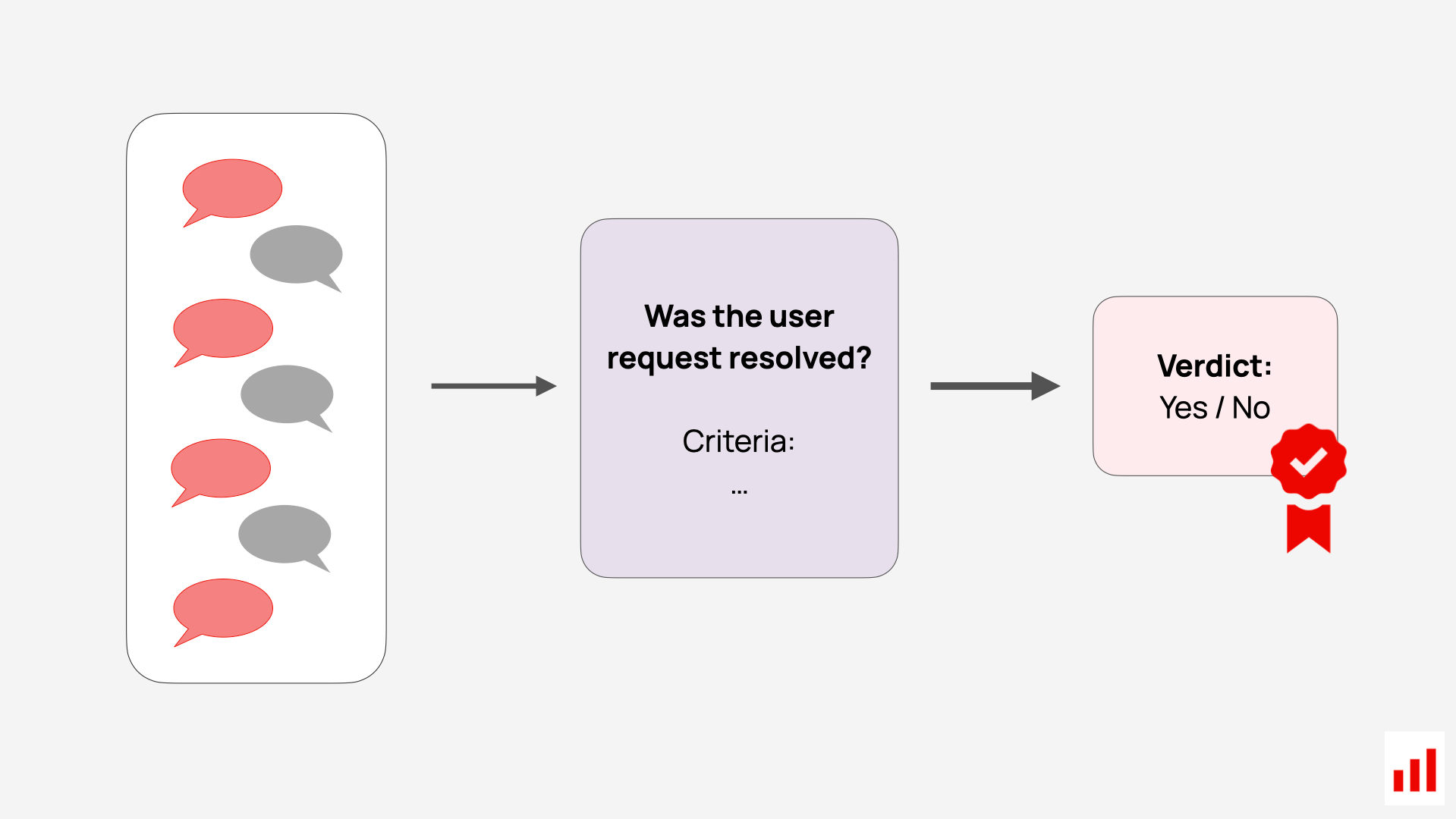
You would reuse the same LLM-as-a-judge approach – but instead of scoring a single response, you pass in the entire conversation and prompt the model to assess things like overall helpfulness, consistency, or user sentiment. The output can be a binary judgment (“solved” / “not solved”) and include diagnostic comments.
While offline session-level testing may be hard to implement, these evals work well in production where you evaluate real interactions. If you enable session tracing (i.e. tracking interactions by session ID to stitch multiple turns into a single conversation), you can easily run automated evaluations over these session transcripts.
If you have a lot of data, you can sample sessions or trigger evaluation based on signals – for example, when a user mentions a competitor, shows frustration, or hits a fallback response.
Ultimately, session-level evaluation helps you catch problems that don’t show up in single-turn checks – like lost context, repeated answers, or unresolved issues. It ensures your AI system isn’t just responding well in the moment, but actually solves the user problems end-to-end.
RAG evaluation best practices
Designing a good evaluation setup isn’t just about picking the metrics. It’s about building practical workflows that help you iterate, improve, and stay close to your real user experience. Here are a few things to get right.
Design high-quality test cases
Your offline evaluation is only as good as your test examples. Before worrying about metrics or writing LLM judge prompts, focus on your evaluation datasets: are they realistic, relevant, and representative?
Start with real data. If you can, use actual user queries, past support logs, or internal search history to inform your test cases. This grounds your evaluation in the kinds of questions people actually ask – not just what you imagine they might ask.
If you use synthetic data, start with assumptions. Even if you generate your test data, you can adapt the process to produce more realistic and varied examples.
Don’t just ask an LLM to generate any questions from a document. Instead, first define your user personas (e.g. “a customer comparing plans” or “an internal analyst reviewing policy”) and generate queries from their point of view. Also, cover topics proportionally – if you expect 40% of support questions to be about refunds, reflect that in your tests.

Always review auto-generated sets. LLMs can help bootstrap test cases, but this doesn’t mean that you should use the test dataset blindly. Once you generate the test set, review it for clarity and structure. Keep the questions that match your use case and discard the rest.
Involve domain experts. These are the people who know the edge cases and what actually matters. Make it easy for them to contribute by reviewing outputs or suggesting test cases. A shared table or lightweight UI goes a long way.
Stick to your test set in experiments. A common anti-pattern is re-generating your test set between runs. That introduces noise and makes your results unreliable. Keep your set stable while testing changes – so you're actually comparing like-for-like.
Update your test dataset over time. However, outside focused experiments, your test set should evolve alongside your product. If you add new features, change policies, or remove outdated docs, update your evaluations to match. And once your system is in production, you can expand your dataset with real user queries and failures you observe.
Choose metrics that matter
Good evaluation is contextual. It isn’t about running every possible check – it’s about picking the right ones based on how your system fails and what quality means for your use case.
Don’t look for a single catch-all metric. You shouldn’t expect to come up with one perfect evaluator. It’s totally fine – and often necessary – to use different evaluators for different tasks. For example:
- When tuning retrieval, focus on chunk-level relevance scores and ranking quality. Once that’s stable, you can move on and not use these metrics further.
- In stress tests, use custom evaluators like brand safety or refusal checks. They will be scoped just to those testing scenarios and used in regression testing.
- In production, you can track a few high-signal metrics like faithfulness, format correctness, or answer completeness, plus analytical checks like topic coverage.
Prioritize based on observed errors. In theory, you could score everything: tone, hallucinations, completeness, coherence, etc. But in practice, this only adds noise. An anti-pattern is scoring 9/10 on “goodness” using generic metrics that don’t catch real issues or help you measure the difference e.g. between prompt versions in a meaningful way.
Instead, you should look at real outputs and identify what actually goes wrong or risk worth testing for – then choose a few high-leverage tests and metrics to track.
Create custom LLM judges. If you are using LLM evaluators, you should write your own evaluator criteria. Even checks that look generic at a first glance like “correctness compared to the ground truth” may have a few nuances – so make your expectations clear.
For example, while obvious contradictions between answers are easy to spot, you may have different ideas on how to treat additions, omissions or small changes (e.g. explaining acronyms, changing date formats) between reference and new answers. These are worth clarifying in a prompt.

Align your LLM judges with human labels. LLM judges help scale human labeling – these are not some fixed metrics set once and for all. Don’t rely on off-the-shelf prompts – your goal is to make automated reviewers that align with your labeling criteria.
So when you create these judges, you should start with manually labeled examples, and calibrate your LLM judges to agree with them. You can also consider using automatic prompt optimization techniques to achieve this.
Avoid perfection traps. Don’t aim for “the best possible evaluator.” Aim for something useful. You can always iterate on your test cases or your LLM judge prompts. What matters most is having a working loop where you can spot issues, try fixes, and know if things got better.
Make the workflow practical
Designing good evaluations is just the start. You also need a setup that you can run consistently. Here are a few ways to keep your workflow practical and manageable:
Be pragmatic. Not every system needs full-stack evaluations. If you're building a simple support bot over a small help center database, a few spot checks and basic correctness tests may be enough. Don’t over-engineer. Of course, a customer facing a medical chatbot is of course a different story.
Start with the question. Choose evaluation workflows based on the decision you’re trying to make. Are you comparing prompt versions? Testing if the system is good enough to ship? Checking if real users are getting good answers? Let these questions guide your setup – not the metrics alone.
Start small, then grow. Evaluation can feel overwhelming – especially with all the possible metrics, edge cases, and tooling options. It’s totally fine to start with a small test set and a couple of key checks and continue with manual review for a while (that’s actually recommended since it helps you figure out the criteria). You don’t need perfect coverage from day one. Focus on the highest-risk scenarios first and expand from there.
Build collaborative workflows. Make it easy to view, comment on, and review test cases, model outputs, and evaluation scores – especially for non-technical stakeholders. Designing test cases or giving feedback on LLM system behavior often requires domain knowledge, so it can’t just be the engineering team’s job. Set up simple interfaces or shared spaces where product owners, support leads, legal, or other reviewers can contribute directly. This applies to both development and production.
Don’t forget to keep records – knowing what was tested, when, and how is more valuable than it seems, especially when debugging regressions or making deployment decisions.
Allocate real time and ownership. Evaluation takes effort – writing test cases, reviewing model outputs, maintaining datasets. If it’s an afterthought, it won’t work. A good idea is to treat it like product infrastructure. Assign owners and make it part of the product release process.
Using Evidently for RAG evaluation
Evidently is an open-source evaluation framework for LLM applications, with over 25 million downloads.
It combines a Python library and a web UI – built to help you run, review, and track the full lifecycle of AI system evaluations, including RAG. You can use it for experiments, regression testing, and ongoing monitoring.
1. Generate synthetic data
You can use Evidently to generate synthetic test cases – tests inputs or question–answer pairs grounded in your actual knowledge base. This helps you bootstrap evaluations for RAG correctness testing.
You can generate data using the Python API or use the UI to inspect and review results. The UI is designed for collaboration – so domain experts can help design or validate test cases and outputs without needing to code.
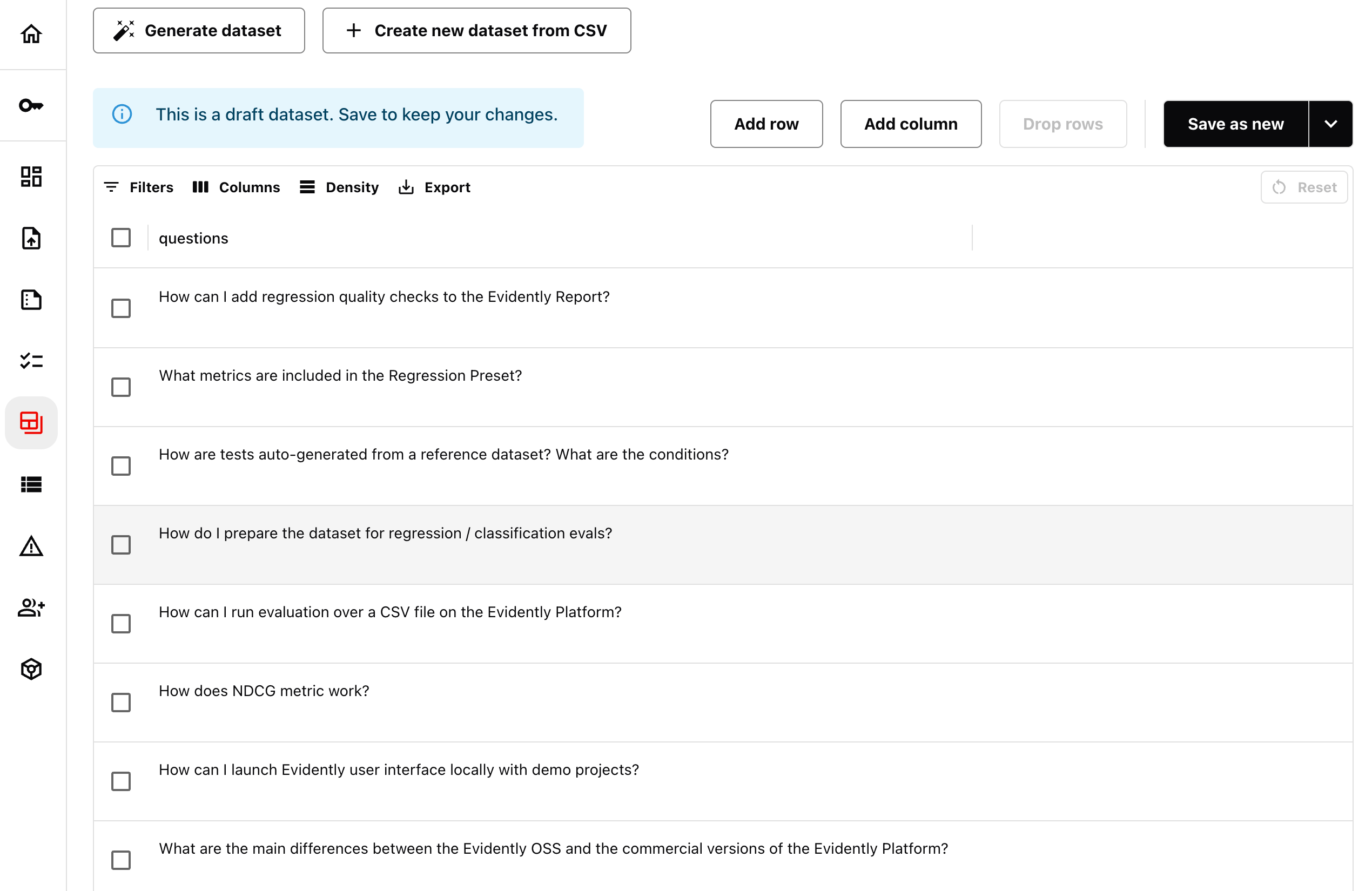
2. Run built-in and custom evaluations
Evidently comes with built-in RAG metrics: from ranking metrics like precision@k and hit rate to customizable LLM judges for retrieval and generation quality. These follow the evaluation methods described earlier in this guide.
You can also define your own evaluation criteria and run prompt-based checks for things like correctness, tone, format, or safety using built-in evaluator templates.
If you prefer no-code, you can also run evaluations directly in the UI – just upload your examples, apply LLM judges, and explore results interactively.
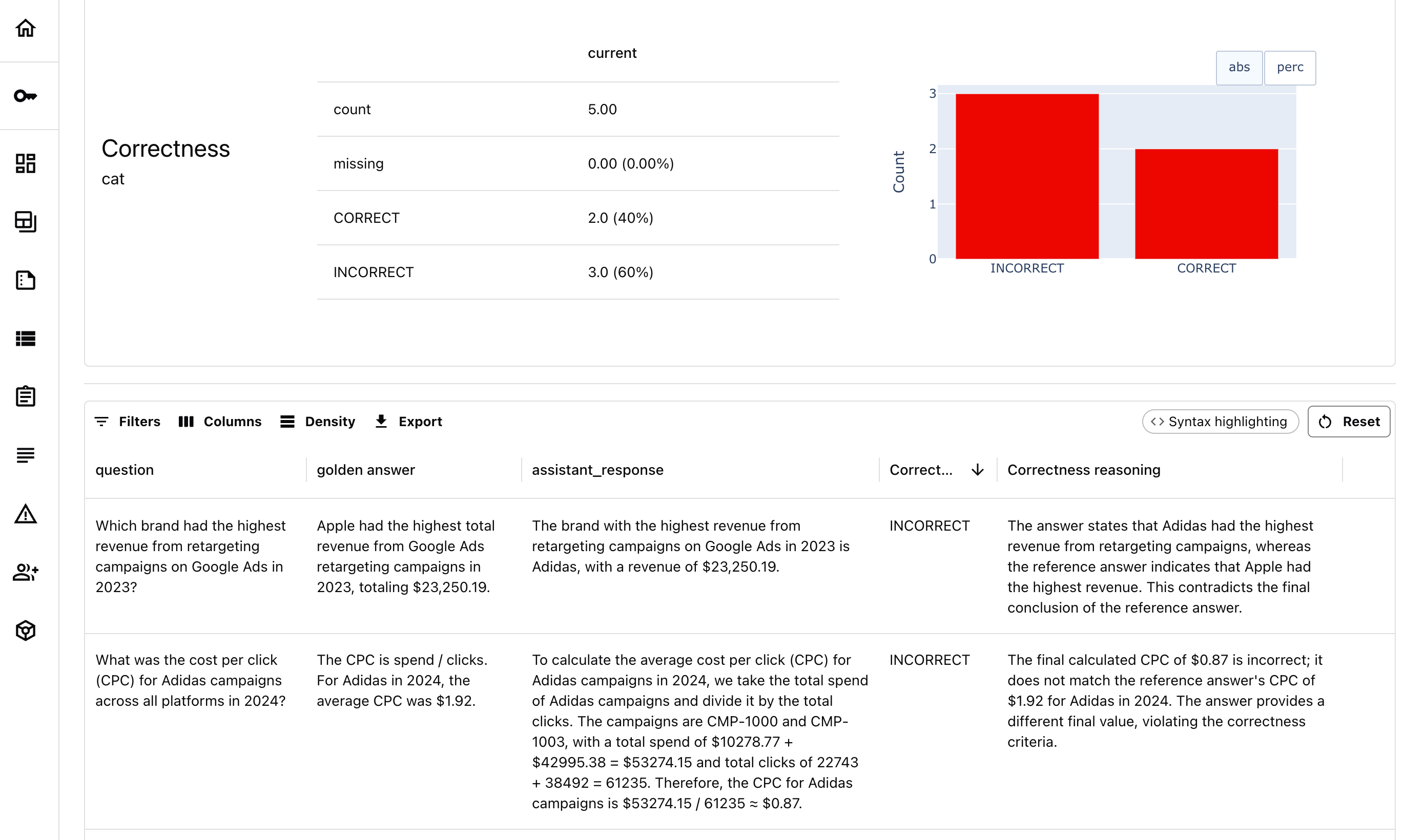
3. Track evaluations over time
Evidently is designed for continuous evaluation. You can run tests across experiments and regression checks, or monitor production runs – and track how results evolve over time.
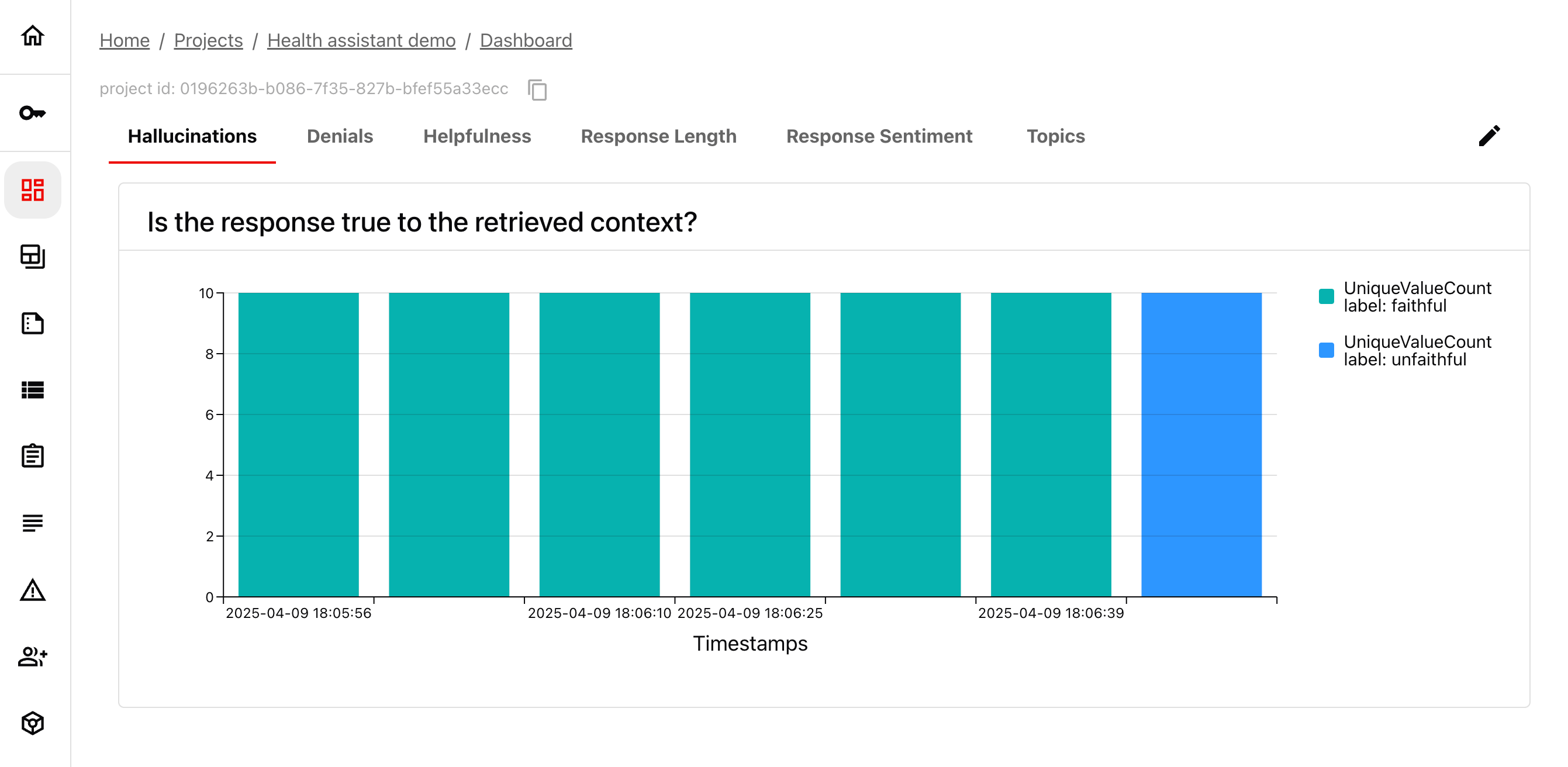
It also includes in-depth tracing – so you can go from a metric drop to specific query failures and dive deep into what went wrong.
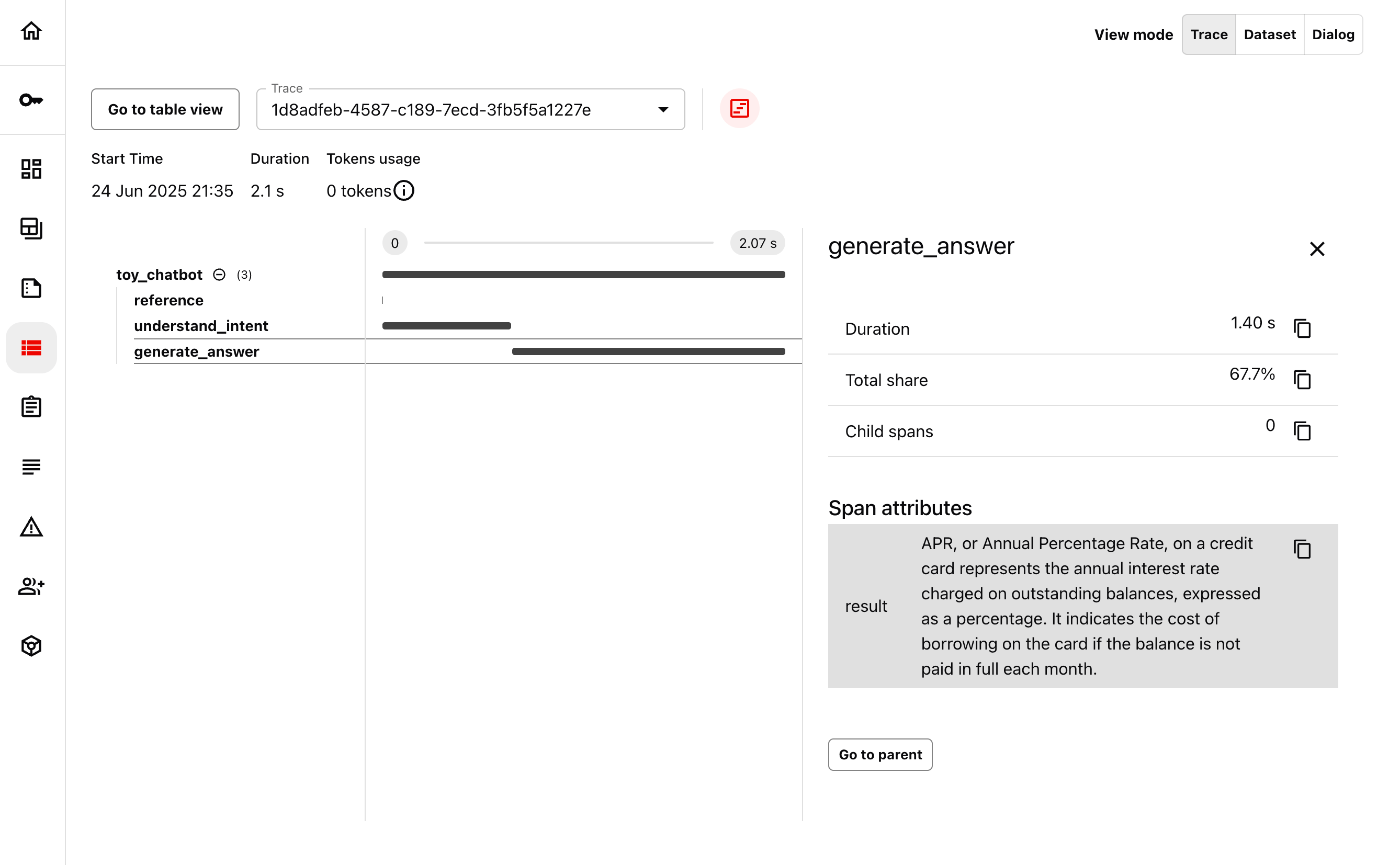
Recap
Evaluating RAG systems isn’t just about checking if the answer “looks good.” It’s about understanding how your system performs in real-world conditions – across retrieval, generation, and end-to-end user experience. That means testing more than one thing: search quality, faithfulness, refusals, tone, structure, and more.
Whether you're iterating on prompt formats, experimenting with chunking strategies, or monitoring production reliability, the key is to use evaluation that fits your workflow – and stay focused on what actually fails.
Useful resources:
- Evidently documentation.
- Theoretical video on introduction to RAG evaluation.
- RAG evaluation methods: code tutorial.
- RAG design and evaluation: code video tutorial.
Read next
Start testing your AI systems today








.svg)



.svg)
.svg)
.svg)
.svg)
.svg)
.svg)
.svg)


.svg)
.svg)
.svg)
.svg)

-min.png)


.svg)
.svg)
